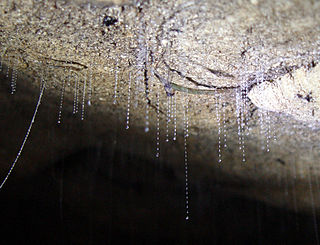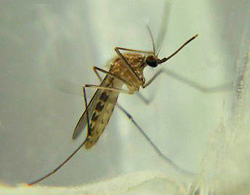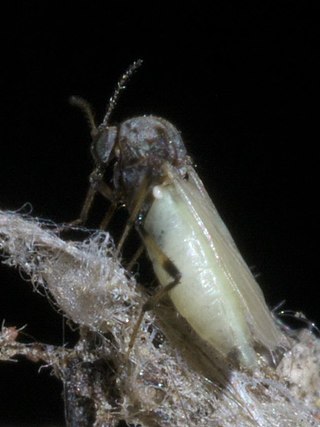
Mosquitoes, the Culicidae, are a family of small flies consisting of 3,600 species. The word mosquito is Spanish and Portuguese for little fly. Mosquitoes have a slender segmented body, one pair of wings, three pairs of long hair-like legs, and specialized, highly elongated, piercing-sucking mouthparts. All mosquitoes drink nectar from flowers; females of some species have in addition adapted to drink blood. The group diversified during the Cretaceous period. Evolutionary biologists view mosquitoes as micropredators, small animals that parasitise larger ones by drinking their blood without immediately killing them. Medical parasitologists view mosquitoes instead as vectors of disease, carrying protozoan parasites or bacterial or viral pathogens from one host to another.

Flies are insects of the order Diptera, the name being derived from the Greek δι- di- "two", and πτερόν pteron "wing". Insects of this order use only a single pair of wings to fly, the hindwings having evolved into advanced mechanosensory organs known as halteres, which act as high-speed sensors of rotational movement and allow dipterans to perform advanced aerobatics. Diptera is a large order containing an estimated 1,000,000 species including horse-flies, crane flies, hoverflies, mosquitoes and others, although only about 125,000 species have been described.

Anopheles is a genus of mosquito first described by the German entomologist J. W. Meigen in 1818, and are known as nail mosquitoes and marsh mosquitoes. Many such mosquitoes are vectors of the parasite Plasmodium, a genus of protozoans that cause malaria in birds, reptiles, and mammals, including humans. The Anopheles gambiae mosquito is the best-known species of marsh mosquito that transmits the Plasmodium falciparum, which is a malarial parasite deadly to human beings; no other mosquito genus is a vector of human malaria.

A midge is any small fly, including species in several families of non-mosquito nematoceran Diptera. Midges are found on practically every land area outside permanently arid deserts and the frigid zones. Some midges, such as many Phlebotominae and Simuliidae, are vectors of various diseases. Many others play useful roles as prey for insectivores, such as various frogs and swallows. Others are important as detritivores, and form part of various nutrient cycles. The habits of midges vary greatly from species to species, though within any particular family, midges commonly have similar ecological roles.

Arachnocampa is a genus of nine fungus gnat species which have a bioluminescent larval stage, akin to the larval stage of glowworm beetles. The species of Arachnocampa are endemic to Australia and New Zealand, dwelling in caves and grottos, or sheltered places in forests.

Ceratopogonidae is a family of flies commonly known as no-see-ums, or biting midges, generally 1–3 millimetres in length. The family includes more than 5,000 species, distributed worldwide, apart from the Antarctic and the Arctic.

The Chironomidae comprise a family of nematoceran flies with a global distribution. They are closely related to the Ceratopogonidae, Simuliidae, and Thaumaleidae. Many species superficially resemble mosquitoes, but they lack the wing scales and elongated mouthparts of the Culicidae.

Chaoboridae, commonly known as phantom midges or glassworms, is a family of fairly common midges with a cosmopolitan distribution. They are closely related to the Corethrellidae and Chironomidae; the adults are differentiated through peculiarities in wing venation.

The Chironomoidea are a superfamily within the order Diptera, suborder Nematocera, infraorder Culicomorpha. This superfamily contains the families Chironomidae, Ceratopogonidae, Simuliidae, and Thaumaleidae.

Culex or typical mosquitoes are a genus of mosquitoes, several species of which serve as vectors of one or more important diseases of birds, humans, and other animals. The diseases they vector include arbovirus infections such as West Nile virus, Japanese encephalitis, or St. Louis encephalitis, but also filariasis and avian malaria. They occur worldwide except for the extreme northern parts of the temperate zone, and are the most common form of mosquito encountered in some major U.S. cities, such as Los Angeles.

The Culicinae are the most extensive subfamily of mosquitoes (Culicidae) and have species in every continent except Antarctica, but are highly concentrated in tropical areas. Mosquitoes are best known as parasites to many vertebrate animals and vectors for disease. They are holometabolous insects, and most species lay their eggs in stagnant water, to benefit their aquatic larval stage.

Chironomus plumosus, also known as the buzzer midge, is a species of nonbiting midge (Chironomidae) that occurs throughout areas in the Northern Hemisphere.

Chironomus is a genus of nonbiting midges in the subfamily Chironominae of the bloodworm family, Chironomidae, containing several cryptic species that can only be distinguished by experts based on the characteristics of their giant chromosomes.
Mansonella ozzardi is a filarial (arthropod-borne) nematode (roundworm). This filarial nematode is one of two that causes serous cavity filariasis in humans. The other filarial nematode that causes it in humans is Mansonella perstans. M. ozzardi is an endoparasite that inhabits the serous cavity of the abdomen in the human host. It lives within the mesenteries, peritoneum, and in the subcutaneous tissue.
Chironomus riparius, also known as Chironomus thummi and commonly known as the harlequin fly, is a species of non-biting midge. Their larvae are known by the common name of blood worm due to their red colouration. It is common in both North America and Europe. The species was described in 1804 by Johann Wilhelm Meigen. C. riparius has been used extensively as a model for genome structure analysis in insects and is also used in toxicology tests and functional developmental genetic studies. Both their adult and larval forms have been implicated as disease vectors but are also an important part of freshwater food chains.

A gnat is any of many species of tiny flying insects in the dipterid suborder Nematocera, especially those in the families Mycetophilidae, Anisopodidae and Sciaridae. Most often they fly in large numbers, called clouds. "Gnat" is a loose descriptive category rather than a phylogenetic or other technical term, so there is no scientific consensus on what constitutes a gnat. Some entomologists consider only non-biting flies to be gnats. Certain universities and institutes also distinguish eye gnats: the Smithsonian Institution describes them as "non-biting flies, no bigger than a few grains of salt, ... attracted to fluids secreted by your eyes".

Bezzia nobilis is a species of biting midges in the family Ceratopogonidae. It is widely considered one of the most common Bezzia species; it is found in Eurasian regions, all over the United States, Central America, and even into South American countries like Brazil. B. nobilis seem to prefer aquatic environments; they are commonly observed in stagnant water pools in Eurasia regions and marshes in the southern United States. Adults of this species are easily distinguished by their black and yellow striped legs. Pupae are recognized by their brown bodies, abdominal spines, and respiratory horns. B. nobilis larvae are distinguished by brown heads and white bodies. Little information is known on their life cycle or mating habits. B. nobilis is a predatory species. While some research suggests they mainly feed on larvae of other insect species, experiments suggest they prefer immobile, easy prey such as dead adult flies, bacteria, and protozoa.

Opifex fuscus, known commonly as the saltpool mosquito or by its Māori name naeroa, is an endemic mosquito that is widespread along the coast of New Zealand.
Chironomus annularius is a species of non-biting midge in the family Chironomidae. It is usually found in regions with bodies of fresh water but can be found in almost every environment. It tends to form "hotspots" around specific areas. The species is distinguished by the size of its chromosomes and the lack of a proboscis.

Tokunagayusurika akamusi is a midge fly species of the family Chironomidae, commonly called "nonbiting midges" or "lake flies."














